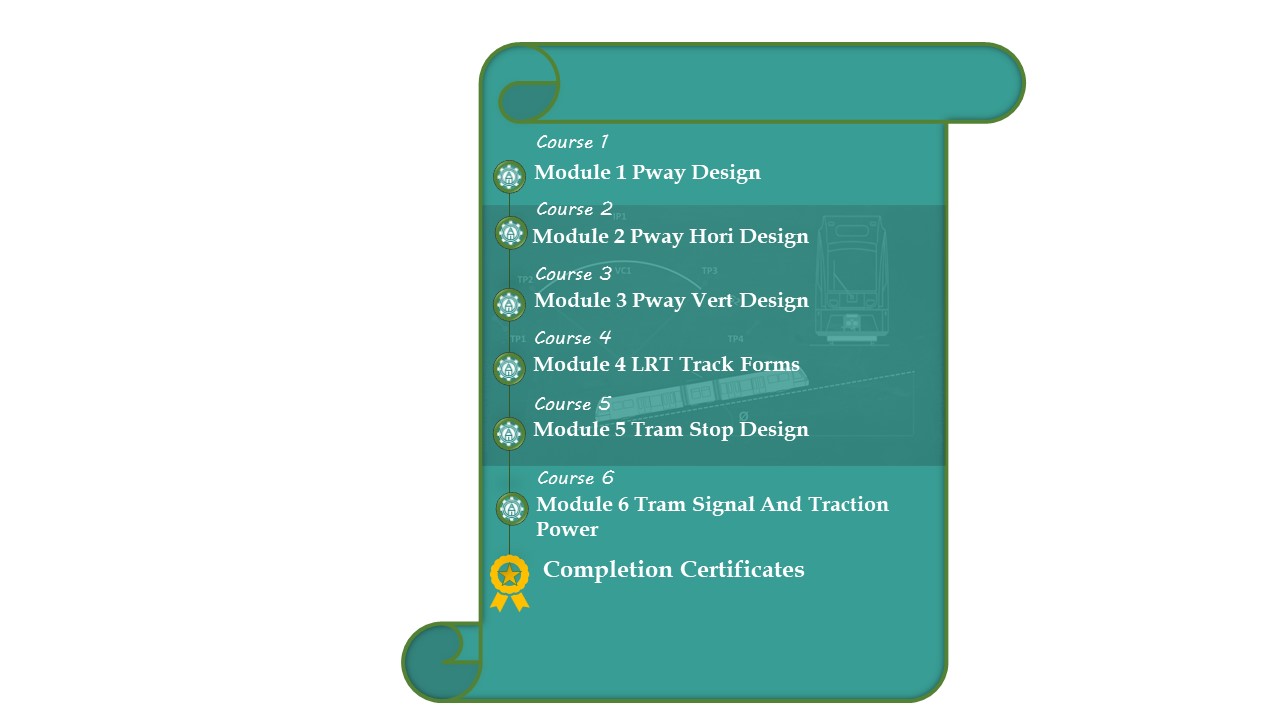Details of Courses
P-way Design involves the design, construction, operation and maintenance of Light Rail Transit (LRT), Heavy Rail Transit (MRT) and Highspeed Rail (Bullet Trains) to ensure safe and effective transportation of people and goods.
The course modules share P-way or LRT Design in a detailed manner. The course has covered key industry of P-Way Design, Elements of P-Way such as LRV Bumpers, vehicle dynamic envelops, etc. The course module the design process track, horizontal design, vertical design, superelevation, the speed at curves, and track components, etc.
The course also covers different type of Track Forms such as Ballasted Track Forms, Embedded Tracks. Along with this, the course covers key features of Tram Stop, type of stops, surface finish, etc.
-
In the First Module, we have commenced the course with the key industry of P-Way Design. The module then explained the features of Tram like LRV vehicles, pantographs, crash energy management (CEM), LRV Bumpers, vehicle dynamic envelopes, platform clearance, etc.
-
In the Second Module, we have described Track horizontal design and covers link and curve section design, superelevation or cant deficiency and superelevation unbalance. The course module has also described how to define the speed of LRT Track at curves and the categories of speed at curves such as overturning speed, safe speed, maximum authorised speed and signal speed.
-
In the third module, we have described Track vertical alignment design and covers vertical gradient, crest curves, sag curves design along with design guidelines and design formulas. Thereafter, the module has described trackwork component such as Turnouts, Crossovers, Switches, Cross-Rails, Frogs, check-rails, and Pocket Tracks.
-
In the fourth module, we have described LRT Track forms, stiffness of track, and track modulus. Thereafter, the modules have described various Track forms such as Ballasted Track, Direct Fix Track, Embedded Track, Floating Track and Tracks in the transition zone. The module has also covered various forms of Track Sleepers such as Timber Sleeper and Pre-cast concrete sleepers. The module described the formula to determine the spacing and factors of the sleepers that affect sleeper spacings.
-
In the Fifth Module, we have described LRT Tram STOP design and its types like Island Platform and Side Platform. The Module then covers components of Tram Stop such as shelter, walkways, ramps, steps, signages, lighting, Passenger Information, etc. It has also covered the Platform surface finish and Tactile.
-
In the Sixth Module, we have described the Tram signal system, signal equipment, traction power system, distribution system, substation system and catenary system. Within the Tram Signal System, we have covered the switch machine, impedance bonds, loops and transponders, wheel detectors, axle counters, etc.

| 1. Welcome to Online Exam for Fundamentals of P-Way Engineering
2. Total Time for Exam is 60 Minutes 3. No Negative Marking Best of Luck for your Exam |
| Exam available after course completion |

GCE Mentors admin
GCE Mentor is a group of Civil Engineering experts from the industry. Mentors prepare, compile the course content and review it before publishing. Several iteration and value addition takes place before publishing the course. It is vital for Mentors to not only make the course engaging but also provide important and advance information to GCE Students. We would encourage to GCE students to please share their feedback of every course module as they progress the course. Your valuable input will not only improve our current courses, it will also help us to understand Student’s perspective so that we can improve our upcoming course modules.



